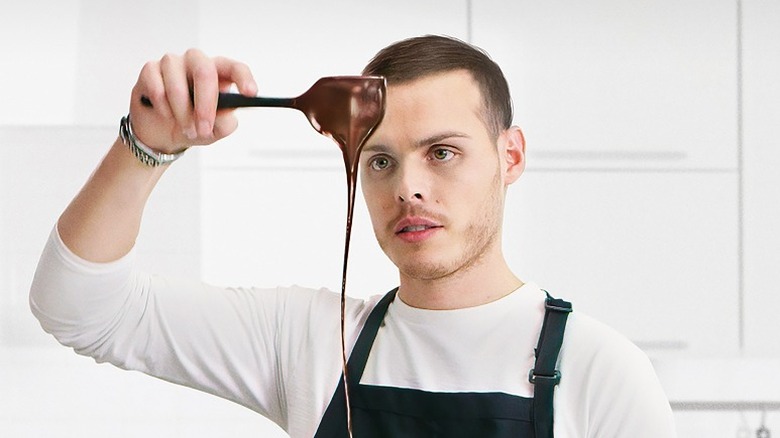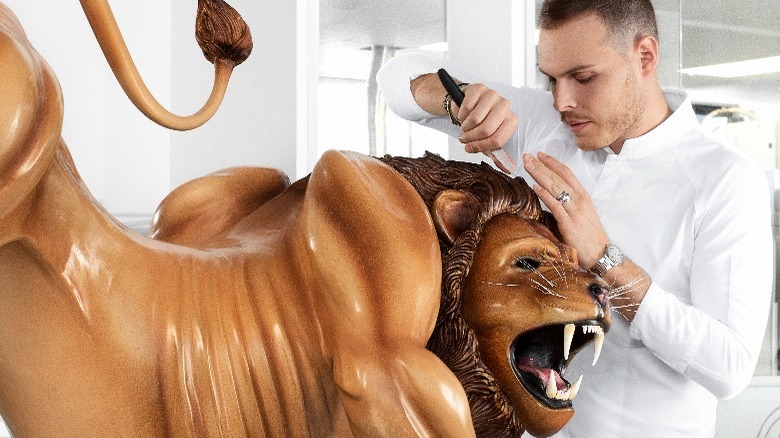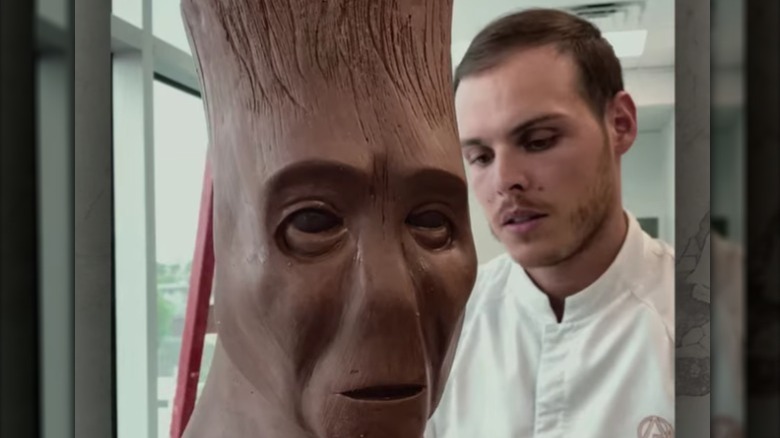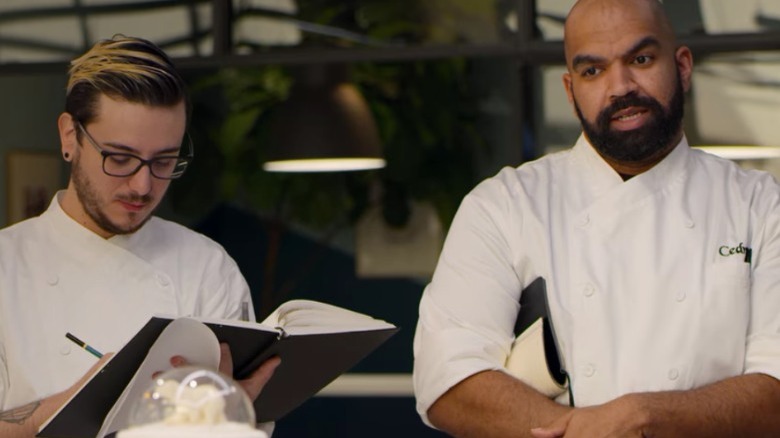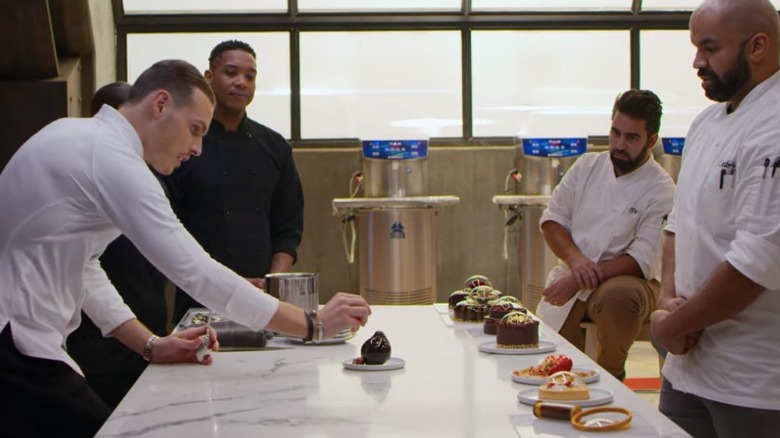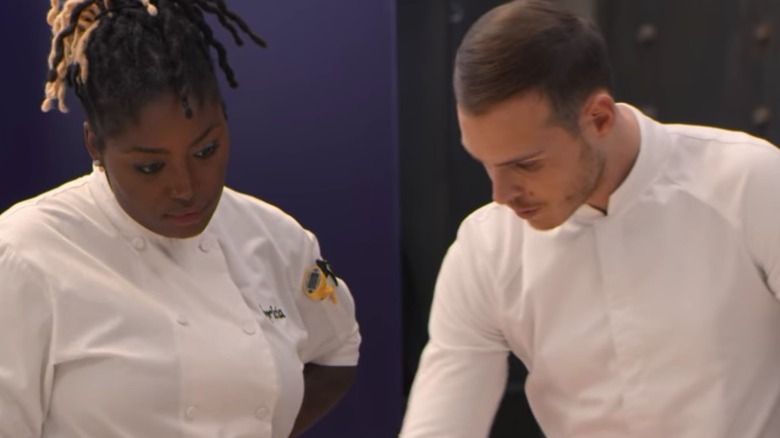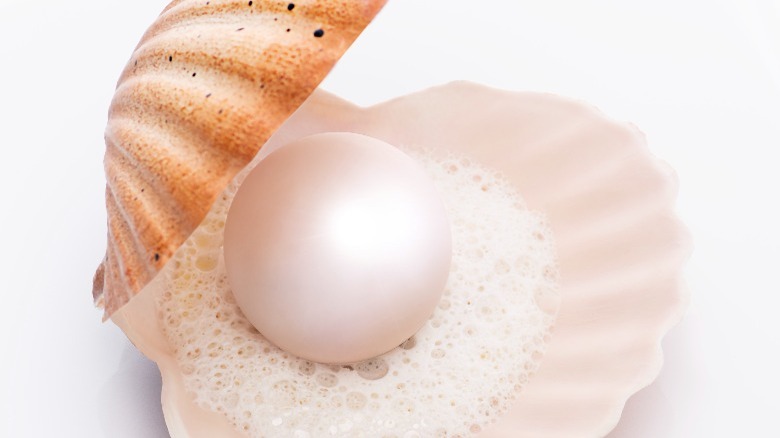Amaury Guichon Tells All About Chocolate, Showpieces, And The Art Of Pastries - Exclusive Interview
Meet Amaury Guichon. Tear your gaze away from his four-foot-tall, impossibly-detailed spinning chocolate Ferris wheel. Stop staring at his ethereally beautiful and seductively perfect coconut-vanilla pearl pastry. Meet Amaury Guichon, the person. He's a teacher, a husband to Fiona, and he's a newly-minted Netflix star. He's always in the kitchen, working six days a week and hardly taking vacations. He may have renounced fast food, but he has only ever given up on one project.
If you haven't been obsessing over Guichon's creations on social media for years (five million of us have), you're familiar with his work from Netflix's "School of Chocolate." In it, Guichon plays part-magician and part-mentor to eight contestants who — through pastry and chocolate showpiece challenges — compete to take home a $100,000 prize. "School of Chocolate" isn't quite like any other televised pastry competition out there. We'll let Guichon tell you himself, and in this exclusive interview with Mashed, the Geneva, Switzerland-born French pastry chef gives us a behind-the-scenes peek into the creation of the series and lets us in on some of his secrets along the way.
Meeting Fiona changed Amaury Guichon's life
You've said that to succeed at what you do, you should find somebody that inspires you on a daily basis. Who is that for you?
Who inspires me on a daily basis? I don't have one particular in mind that is a role model. I think I met a lot of people within my whole life/career who inspired me to be better on a certain level. But I don't have a mentor or someone I look up to that kind of guides my every decision and move in my career, unfortunately. I think surrounding yourself with the good, the right people [is important]. And it's funny, you meet some people at some stages, whether you know it or not, they will unlock some possibility for you. And maybe they don't even know it, whether it's [a] mental or physical opportunity. I think the key [to] succeeding is being able to recognize when an opportunity arises. Don't be scared to take it because once the opportunity has passed, it might never represent itself.
Can you remember one instance in your life where that happened?
There [are] multiple. There is no one turning key point in my life. I think there [are] multiple turning points, but I remember having one chef when I was an apprentice in Paris, who really inspired me by his professionalism and his kindness. I remember when I was [doing] my first job in Paris as a chef, I used to be an apprentice [to a chef] ... They brought up a TV show that was just launching, which was the very first pastry professional TV show in France. And at the time I told him I wasn't interested because I had so much work and he kept on very insisting. And he said, "It's made for you. You have the right profile. You have the look, you have the charisma, you have the skills," et cetera. He kept on pushing.
And eventually, just as a joke, I gave my application and I ended up being on the show and did very, very well on the show. And this opened a whole other network of people that were able to bring me to the U.S. Once I was in the U.S., I think the biggest turning point after that was meeting my wife [Fiona], who was able to give me, how to say, the confidence I needed to become the chef I am today. [She is] able to work behind the scenes, to make sure I can focus on the craft and that everything behind the scenes [is] taken care of. Because most of the time, as a chef, you have to do every single aspect, which doesn't allow you to be able to really focus time on what you're good at, which is your craft, creativity, recipe making, et cetera. And when I met Fiona, I was able to. It was another turning point, probably the latest turning point in my life. Yeah.
A day in the life of Amaury Guichon
What does a day in your life look like from start to finish?
I usually work about six days per week, five days in the kitchen, and one day editing the content for the week after that. I always have a plan. So on this Sunday, my day off, I plan the week after that: what will be done, et cetera. I don't have like — well, I do have a routine now that I don't travel as much because COVID canceled my international trips. But I used to — for the last four years — travel the world and teach in private schools, only pastry oriented. My daily routine at the time was going on [a] plane. Every other week I was in some part of the world, whether it was Latin America, America, Asia, Europe. But now I'm mostly at the Pastry Academy in Las Vegas.
And there is a week I teach my long-term students — whether it's wedding cake sugar showpiece, chocolate showpiece — elaborate modern style entremets. Or I create content for the social media platform, or rarely, but it still happens, I do [a] commission job. So I'm kind of always, always in the kitchen. We rarely take vacations. And I cannot say that my life outside of the kitchen is very interesting.
Who is one chef you'd want to cook you dinner?
Hmm, that's a good one. Being in the pastry industry, I'm really not involved so much with savory chefs. I don't know if I can pick one in particular because I have great respect for many savory chefs. I think having a dinner, a personal dinner by Gordon Ramsay must be very, very entertaining because he's a fun guy, even though he is a little bit harsh in the way he approaches things, but this would be very fun. But there are so many other talented individuals, whether it's in the Nordic countries, or in Spain, or in France, or in Italy, or in Asia. Oh gosh. Do I have to pick one?
What's one ingredient you can never live without? Chocolate must be one, but do you have another one?
Yeah. Chocolate is a very obvious one, and it's really true because without this beautiful ingredient I would not be able to do most of my work. I will have to pick vanilla, because vanilla, not a lot of people know that, but vanilla is a flavor-exhausting natural ingredient that we use in many, many of our preparations. It just has that, it's not sweet per se, but it encourages and gives a floral aspect to the sweetness of our elements that we put in desserts. So I pretty much put vanilla in everything. And lately vanilla has been becoming harder to get, more expensive to get, because big industrial companies [have] got into the vanilla product [business] and bought so many plantations and jacked up the price. But if not chocolate, vanilla would be the second one.
What is your go-to fast food order? And from which restaurant?
That's going to be tough because I don't eat fast food.
Nothing ever?
It's not nothing ever, but I stopped, years and years ago. I used to like In-N-Out, but yeah, I'm trying to stay away from fast food. As I'm getting older, I found that it's a lot harder for me to digest. I feel very heavy after, I feel almost sick. So I kind of removed it from my diet. Personal choice.
The chocolate showpiece that gave Amaury Guichon 'the most joy'
Your showpiece creations have taken up to seven days and can reach up to seven feet in height. Does your mental state change when you're in the middle of one of these super-detailed projects?
Most showpieces are done within four days of work, for the most elaborate ones with a ton of details, such as the motorcycle, et cetera, it can go up to seven days. But ... I'm always excited about the next project. So I could not work on a one-month showpiece. I don't think I could, like, mentally do it. I like to start, I love the process, but I love to see the end result and one month would be too long. The mental state does change. Absolutely. It's funny you mentioned that. You go in with a game plan, and as you discover — creating art is difficult, creating it with a material such as chocolate, which chocolate is so unique. It's one of the rarest natural elements that's fat-based that can have two consistencies at the exact same temperature. At 26 degrees Celsius, the cocoa butter, which is the fat extracted from the cocoa bud — cocoa bean — can either be solid at 26 or liquid.
I respect a lot of different fields and artists. You take wood, you take clay, they all have their specificity, but something breaks with clay, you add more clay, that's it. And then it dries out. With chocolate, it's different. Everything can collapse. And it all depends on how you did the structural work [and] the atmosphere you work in, et cetera. So, sometimes I go in with an idea on how to proceed in making the piece, because mine aren't only sculptures, it's mostly architectural. You have to find techniques to accomplish your vision [by] using a minimum amount of chocolate, because one, it's expensive, and the more you use, the heavier the piece is, the heavier the piece, the less stable it is.
So the lighter the better. And yeah, in the middle of the process, most of the time, it turns to success based on what I wanted to do, but mid-process, sometimes I have to reevaluate how to do [a] certain part of the piece and change my game plan. Mentally, it's really draining to do a showpiece. And once it's done, I usually need that day to shut my eyes and sleep. That's why it's a little bit boring when I'm not working because I really recharge my batteries. Mentally, it's super draining.
You've kept your chocolate showpieces for up to ten years, I think. Is there one that is the most meaningful to you?
Not always, but I say 80% of the time I do like them and almost have a little emotional attachment to them. I don't think one strikes me more than the other. I do love the feeling I can get when I craft it. I think the one that gave me the most joy was the one that was featured on the Netflix TV show, "School of Chocolate," the father nature one. This one came out just so naturally. It took me only three days. And it was just a very nice, non-painful process. And from vision to finish everything went according [to] plan. I don't know, it was just a nice feeling.
The only time Amaury Guichon has given up on a project
You create almost impeccable, perfect pastries and chocolate illusions that we get to see on Instagram. What are your biggest failures? We never see you fail.
So I'm human, of course. Sometimes things don't go according to plan, but because I'm able to post one creation per week, that means I'm usually always succeeding every week. I don't have a biggest failure. I can give you a little insight if you want a funny story ... On a small scale, working chocolate becomes very tricky. Every thin detail can melt so easily with your hands. And then when you apply the color, because it's an edible color, which is cocoa butter, which has a certain viscosity, it's not as fluid or liquid as water-based color. This can really remove design. Originally, I wanted to put the plane onto the [chocolate showpiece] challenge [in "School of Chocolate"] where you see a rocket ship, do a plane.
I spent a full day working on the plane. And it's the only time I actually gave up on a project because I knew the level I wanted to accomplish, I would not be able to reach [it] at that time. Because I wanted to craft little sugar windows. I just, I went with a simpler ship just to be able to make it work. Because very small, extremely detailed, modelist real-life oriented projects are not my favorites. I don't have an epic fail where, okay, I built that three, that five-foot-tall showpiece, and because I forgot something everything collapsed. This, so far, has not happened to me.
Is there one flavor profile that you have that has so far alluded you or that you are looking forward to playing with in the future?
Flavor profile-wise, my creations are pretty much always based on the same ideas, which is instead of trying to jam as much flavor as possible and making it taste good, I try to express one flavor through the use of textures, and in multiple ways. Because you can eat a strawberry, you can eat a fresh strawberry, you can eat a flavored yogurt strawberry, it's still a strawberry flavor, but your mouth senses it in such a different way. And my idea, when I craft something, I try to work on one flavor, usually highlighted by a secondary one that isn't really essential in the name of it. But just to exhaust the flavor and textures, usually playing with textures [to] open parts of your taste buds that usually can be less receptive if you don't have that texture, which allows you to feel flavor in a very different way.
As far as what I like, flavor-wise, I love exotic flavors, and I love simplistic cakes. Mine do look elaborate, there is a lot of work in [them], but when you look at it, it's pretty straightforward. You have a crunchy element, you have a smooth [element], [it's] very intense flavor-wise, whether it's a compote, a cream, et cetera. Then you have a sponge for the textured parts, and also to absorb some of the moisture. And then you have a mousse that brings some lightness, some freshness to the recipe. The rest is tricks and decor to make it look very appealing.
Behind the scenes at 'School of Chocolate'
We never, obviously, got to taste any of the creations on "School of Chocolate." Could you name one or two pastry winners in terms of flavor-profiles only?
The lily pad was the very first time I used matcha in a dessert. And if you like matcha, this one was actually very, very tasty. And the look [of the dessert] just did not look like your regular pastry. The one, well, I love the treasure chest because baba is one of my favorite pastries ever. And the one I came up with, it's extremely exotic-oriented with like a rum-passion fruit vanilla-lime syrup. And then you have the very fresh coconut vanilla mousse, and you have the very intense in flavor, pineapple-mango exotic compotes. [It's] very simple — three components — and it's very delicious. There is also the snow globe, which is a reinterpretation of one of my classic desserts called Fiona, that I did for my wife, which is an all-white dessert based on vanilla and almond flavor. Usually, this one is the one that pleases all my students. They love this one.
Can you take me behind the scenes of "School of Chocolate?" Is there anything that the cameras didn't show that you can let us in on?
There [was a] ton of additional content because, as you know, it's a pilot, so we always have more content. On my Instagram later on, I will be featuring some of the creations that were not featured, but did happen during "School of Chocolate." Some insights ... everything you've seen on camera was a pretty much accurate representation of what genuinely happened on the show, whether it was the timing — that was always accurate. The difficulty of the challenges, the organic growth of skills of the students.
And of course, it's not only the result of me teaching them. It's the result of them acquiring more skills from me, but also from each other and being more comfortable in their surroundings in the kitchen from the first piece to the last one. Everybody improved on their comfort level, and their skills really show. The more we [progressed] the more I was happy to be able to see them fully express themselves and be happy [with] what they've created.
I really like all the students, just like it probably shows through the show. I think they worked well together, even though there was like a competition dimension to the show, of course. I think, behind the scenes, I know that off-camera, they did exchange recipes and help each other out based on what they knew, which made me so happy. [In] most competitions, people want to win and fight for themselves. But when you actually understand this is a school and people are willing to help each other off-camera so their competition [pieces] can shine better — I thought it was very, very helpful.
Amaury Guichon's favorite 'School of Chocolate' creatons
If there was a bloopers reel for "School of Chocolate," what's something we might see?
Bloopers for "School of Chocolate?" ... I mean, the dolphin falling down was a pretty good one. Something that you would've not seen? I don't know. I think you know, my English is not [my] first language, and I think the edit did an incredible job [of] removing some of me trying over and over to say the right thing. I don't know if this would be considered a blooper, but I don't know. I don't think we had a lot of [failures]. For [a] first [season], a pilot and recording during COVID, everything went pretty smoothly. So there is nothing really too, let's say, too article-friendly to make it like a big, big news, unfortunately ... One funny blooper, but I don't know if this could be a blooper. I think it's when Tyricia Clarke, the second time she did a chocolate and raspberry flavor, I tasted it and I recognized that it was my chocolate mousse, and asked her to show me the recipe she used. And it was actually the mousse from my own book. So I thought it was kind of funny that she put that [in her pastry] and she did it very well. It was actually a great success. But it was very funny that she would use my own recipe to try to wow me.
Were there any creations that came out of the show from your students that particularly surprised you?
Yeah. I know how difficult it is to create illusions [and] elaborate pastries, even more so when you are not in your [own] kitchen. So the sets, I was part consultant producer, so I made the sets with all necessary equipment for them to succeed. And they probably had more equipment than they would have ever had in their own kitchens. So they had everything to do it, but now it's still a challenge to be able to do it while being recorded, while being ... timed. I think they all had great ideas. When you see them not succeed, I think it's because of the time constraints, and not for a lack of ... skills. Flavor-wise, some of them really surprised me. I can recall Cedrick's inflated pear, with the wine and pear. This was surprising and extremely good. I did not expect that because I know how tricky it is to balance wine into desserts, even more so when it's red wine.
I think that during the sugar challenge, what Juan did, in my opinion, was close to perfection. As far as flavor, I would not be ashamed to sell that if I had a dessert shop, everything was balanced. The look of it was sexy. The cut was perfectly centered. You can always work a little bit on the glaze, have something shinier, but as far as the taste of it, it was incredible.
What really happened to the students who sat out of chocolate showpiece challenges
Is there anything that you will do differently in a Season 2? Are we going to see a Season 2?
I honestly have no idea! We won't know until much later down the road. Netflix holds all the keys. I would like for [there] to be a season two, because of the great positive feedback we've received. If we had a season two, I believe that the format would remain the same. We all loved the fact that there were no eliminations and people were here to learn no matter what. No, I would just try to come up with interesting challenges, whether it was for the audience or for the student to learn. But I think we would keep a very similar format.
You'd always take two of the students out of the chocolate challenges to train them in techniques. We didn't get to see a lot of that in the show itself. What happens during that time?
Yes. So of course, when you only do a 30-minute type of show, you have to sacrifice some of the content. And if there is maybe one regret about it, it would be to highlight more of what was happening [during that time]. While the students, the other students, the succeeded students were doing their chocolate challenge, I was taking under my wing, the two, quote-unquote, bottom of the class. And I was giving them the knowledge and techniques to be able to re-do the pastry from the previous round and turn it into a success. And it was actually super, super nice. They have all the footage, but I'm sure it was a decision, probably a good decision, but to focus on another part of the show. But maybe showing more of these [sessions] would've pleased people because we did have a lot of requests on that.
[What you saw on "School of Chocolate"] was a little bit like fast-forwarding while it was probably very interesting. Tyricia Clarke redid her rolling pin, and it looked very good. Amanda redid her coffee pot and it looked very good. So it wasn't, "Oh, okay, you are punished. You're not participating into the next one." It's, "Okay. I don't think you're ready. Let me help you succeed and gain confidence on what you wanted to do previously without the stress of time, without the competition dimension to it." And they all succeeded and it was a great feature on the show. Probably one of the features that is the most changing compared to other pastry TV shows.
Amaury Guichon's advice to aspiring pastry chefs and chocolateirs
In your pastry school, you talk about teaching students the scientific processes behind what they're making. What's the number process that people need to understand to make pastries?
Oh, okay. I don't think there is one rule, but one thing I always tell every student that comes to the school, is in our industry, on social media I do show a lot of the beautiful aspects of what we do. The visual part, the R&D part, the playing with flavors, et cetera. But the day-to-day of [a] pastry chef, you have to be willing to make great sacrifices. And I think if there is one advice I can give every [person] that [is] looking to get into the industry — our industry is rarely rewarding and you have to be willing to sacrifice your birthdays, your holiday, your vacations, Christmas [and] Easter. Because we are working to make other people happy during that period.
And whether you work for someone or for yourself, sacrifices in our industry is the keyword. You have to look down, you have to accept to sacrifice things, and work extremely hard until you can get to the point where your skills and levels are to a point where you can start doing it for yourself and maybe being able to be rewarded for that.
But don't expect to come to school, whether it's mine or anywhere else, and after a few months or years of training, become a chef or open your own establishment, and be able to succeed right away and become the next pastry influencer on social media. It doesn't work like that. I'm very grateful [for] everything that is happening to me at a very young age, but it's very uncommon in the industry. And I think it's a succession of very low-key coincidences and risk-taking I did that brought me to where I am today. But it's not the right standard. It's not the common standard. So I wouldn't give you any advice on particularly a trick or recipe per se. But if anyone gets into the industry, you will have to deal with much more difficulties than what my social media, and every other successful pastry chef social media leads you to believe.
For more insights into Amaury Guichon's spectacular pastry creations and chocolate showpieces, tune into Netflix's "School of Chocolate." Follow Amaury Guichon on Instagram for weekly updates on his latest masterpieces.

